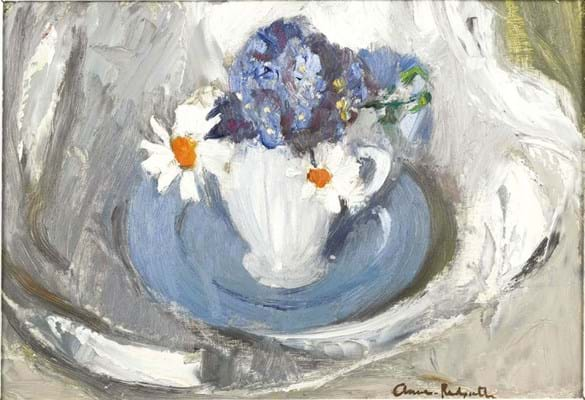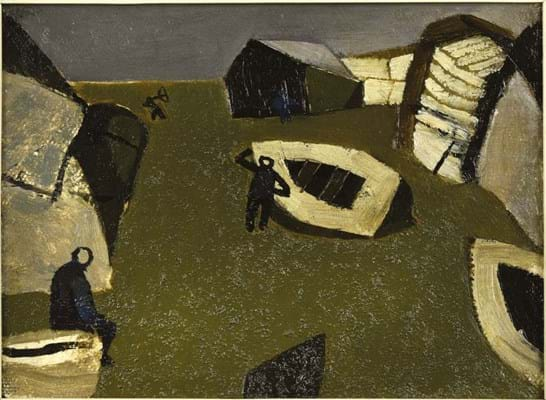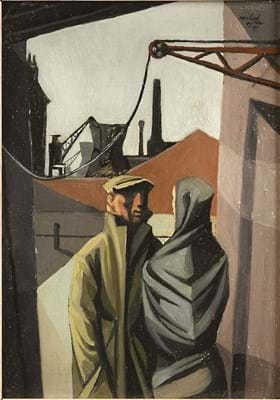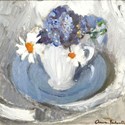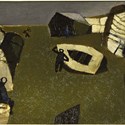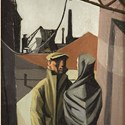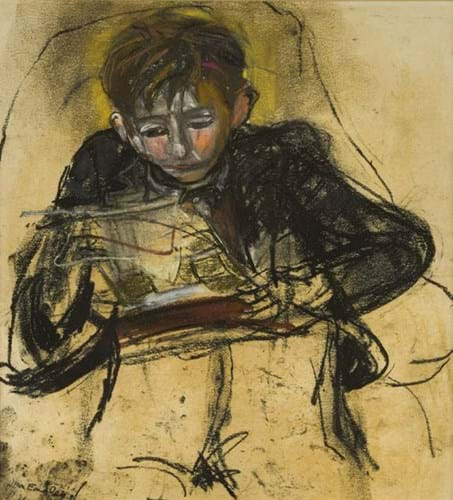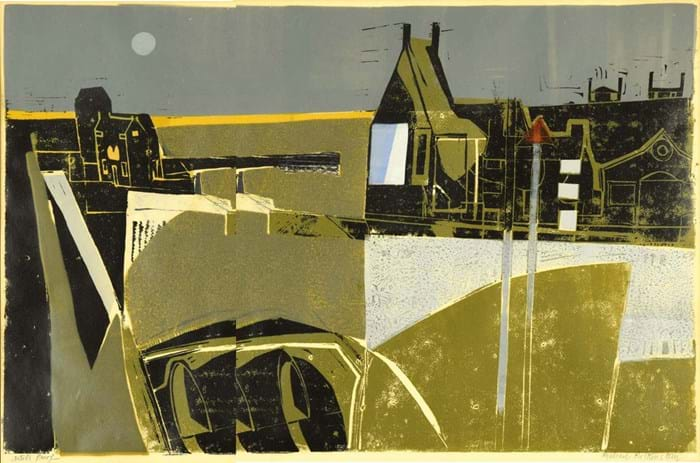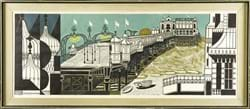The latest such dispersal took place at Cambridge auction house Cheffins (22.5% buyer’s premium) where 152 Modern British artworks owned by Hertfordshire County Council were eagerly received in a white-glove sale on March 21.
The Curated Eye sale contained fresh-to-market oils and works on paper by a list of sought-after names including John Tunnard, Edward Wadsworth, Anne Redpath, Joan Eardley, Keith Vaughan and John Minton. Multi-estimate sums for many works helped achieve a hammer total of £440,000, more than double pre-sale hopes.
A further 300 works will be offered in Cheffins’ Interiors Sales on April 25 and May 23.
Social reform
The art formed part of the council’s 1828-strong collection and were assembled through the so-called ‘School Loan Collection’, an initiative launched in 1949 during the height of post-war social reform to bring original works of art into the classroom.
Art advisers were sent to acquire affordable pictures by contemporary artists, students and graduates from contemporary art shows, many of which took place in London galleries such as the Whitechapel Gallery. The scheme was suspended in 2012 and permanently discontinued in 2017.
As readers will know, this method of extracting funds by breaking up public art collections is not without controversy. Hertfordshire County Council drew criticism on social media, while an online petition to stop the sale going ahead garnered nearly 2400 signatures.
Neither is it the first time a collection assembled by the School Loan Collection has been auctioned. In 2017, Cheffins was also chosen to sell 45 pictures acquired by Cambridgeshire County Council, which went on to total £121,000.
Surrealist creation
John Tunnard’s (1900-71) Brandis 44 – a Surrealist watercolour and gouache canvas possibly named after a Luftwaffe airbase – led proceedings at a double-estimate £37,000 (see News, ATG No 2385). A similar Surrealist creation executed in the same medium, size and year sold at Sotheby’s London in June 2017 for £36,000 – making the Cheffins result in line with London saleroom prices.
Perhaps the most fitting lot from a collection that existed to educate was a pastel and chalk sketch of a young boy reading by the Scottish artist Joan Eardley (1921-63). The 15 x 14in (38 x 35) work was knocked down for £31,000, well in excess of its £12,000-18,000 guide. It sold to a gallery in the north of England.
Eardley’s stark and unsentimental portrait studies of working-class children in Glasgow’s post-war slums were a dominant theme in the artist’s short life. They have since become highly desirable and are found in many significant collections of Scottish and Modern British art.
Current prices range from around £20,000 for small drawings to over £100,000 for the artist’s late graffiti, collage and stencilled portraits from the early 1960s. In March 2018, North Yorkshire saleroom Tennants sold a late mixed-media painting, Girl with a Poke of Chips, from c.1963 for nearly three times the top guide at £87,000.
Redpath still-lifes
Another influential Scottish woman artist in the Cheffins sale was Anne Redpath (1895-1965). She was represented by three works including a trademark still-life, which drew the keenest bidding.
The Blue Plate, a smallish 11 x 16in (28 x 41cm) oil on board, was knocked down at £31,000, tripling its lower estimate of £10,000 in selling to a private buyer. The work is typical of the artist’s use of white and blue colour and flat-surfaced interior arrangements in ‘tilted’ perspective, where familiar household objects are displayed on tilting table-tops.
Redpath’s close association with Scotland’s famous Colourists has meant her prices have grown significantly over the past two decades. Still Life with White Tulips, arguably one of the finest pictures from the zenith of her career in the late 1930s and showing the heavy influence of the Scottish Colourist Samuel Peploe, set the benchmark for the artist at auction when it sold for £216,000 (with fees) at Sotheby’s in April 2007.
'Darlings of Bond Street'
Still-lifes were also the forte of Ayrshire-born artist Robert MacBryde (1913-66), who is closely associated with the work of his lifelong partner Robert Colquhoun.
Together they were known as the ‘Darlings of Bond Street’ during their London heyday, with a string of successful exhibitions at the Lefevre and then the Redfern galleries during the 1940s, before their reputations declined largely due to heavy alcohol abuse. Their work was the focus of The Two Roberts, a retrospective at Edinburgh’s National Gallery of Modern Art in 2015.
MacBryde’s still-life of an oil lamp and a basket of eggs on a table had not previously been known to scholars and is thought to date from 1955-60. It was pursued to just over double the top guide where it was knocked down at £22,000.
According to the Art Sales Index, this is a new record for the artist at auction, surpassing the previous high for Woman by a Fireplace, No 2, which sold at Bonhams in Edinburgh in 2014 for £20,000.
Sentimental seascape
Elsewhere, an experimental 1950s seascape by Keith Vaughan (1912- 77), its main elements constructed as simplified geometric shapes and a ‘gritty’ sand texture for the beach, was pursued to £27,000, selling to a London gallery.
The 10 x 13in (25 x 34cm) oil, Grey Shore Seascape (1950), depicts Pagham in West Sussex – a place where Vaughan holidayed with his friend and lover Harold Colebrook between 1935-39.
Vaughan painted the subject on several occasions in the early 1950s, including Fishermen and Bathers (1951), which resides in a private collection, and Grey Shore with Boat (1950), an oil that was left unsold at Bonhams in London in 2008 against a £20,000-30,000 guide.
A 19 x 23in (49 x 59cm) oil on canvas of oxen by Julian Trevelyan (1910-88) soared to £19,000 against a £3000-5000 estimate (pictured in Previews, ATG No 2383). Similar to a slightly larger picture of the same title in the Tate’s collection, this was one of the best oxen pictures to have appeared on the secondary market. Trevelyan found inspiration for the series on holiday near Siena, Italy, in 1954.
Rothenstein linocut
Further down the price scale, five 1950s linocuts depicting farm machinery and cockerels by Michael Rothenstein (1908-93), who was part of the Great Bardfield School in Essex, all found buyers in excess of their guides. The Blue Window (1955), a 20 x 28in (50 x 71cm) linocut, drew the strongest bidding and was knocked down at £1400 to a private buyer against a £200-400 estimate.
Many of Rothenstein’s 1950s prints combine traditional painting subjects drawn from the surrounding countryside and agricultural community with relief printing and abstract symbols. Farm machinery and the cockerel are recurring symbols throughout his work.
British art historian Frances Spalding gave a talk before the auction. For her views on this collection and the post-war buying spree by councils, see separate story in Auction Reports.


